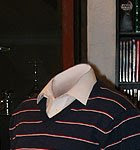Here's a list of things you may want to follow up, and why:
- Open: This one is pretty self evident. If you don't open, you've got a serious learning disability. Ways of getting around this one is reading up on conquering AA or how to give yourself motivation.
- Hook : Did you hook the set (did they at least for a time become positive towards you)? If you don't get these, you're probably doing something wrong when you open.
- Rejection: Were you turned down aggressively or easy? Or did they just ignore you? Depending on how this went down, it could indicate that you're having a problem with delivery, or even ploughing and persistence (staying in the set no matter what). In most cases it's better to be turned down firmly rather than giving up.
- Ejection: Don't tell me you dumped them? Why did you leave? Maybe you should work on getting more persistent. Not that you should stay in a set for hours, but that you push more for close - or even rejection, as a rejection is at least a sign that you are making mistakes, and if you are making mistakes, you are also learning, and learning is progress.
- Pull: Did you pull the girl(s) anywhere? Your ability to pull, to isolate or extract is very important to get the girl into a more private, comfy and therefore more intimate situation.
- Escalation: Did you try to escalate? How soon? Subtly or agressively? Only kino or did you try to kiss her? If you don't escalate, you won't get anything more than numbercloses. And speaking of...
- Close: Did you number close? Did you kiss close? Did you fclose? If you didn't, it could be a clear sign that you've got a closing sticky.
Make a note of each time you get one of these and how it went, and then add them up when you've got some data on it, say after a couple of months to track progress. It's also nice to have a quick look at the data each week for motivation. Always try to beat last week's score. Add upp the data, visualize it in any way you want. Track open to close ratio. Behold, you now have a powerful tool to pinpoint your sticking points.
Statistics aren't for looking at isolated incidents, but for finding a pattern, or finding a trend. Therefore you shouldn't look at single happenings. Stop obsessing over that one time. Instead look for the trend of things. For example, if you eject 10 out of 15 times, you have a problem with too early ejection. The fix? Persistence and ploughing, and not least ability to go for close. It's in fact better to get rejected than to eject, as a rejection is a sign that you've used up all your tricks, and that you may have to learn some new ones to get the success you want (or even unlearn some bad habits).
Happy hunting!

1 comment:
I like this post a lot, and this is why. Way to often I hear people saying that "Learning by doing" is the best way to learn, advocated by Dewey. Dewey said "(...) we only achieve knowledge after acting and as a consequence of the act"*. I don't necessarily disagree with this statement, but learning also a contain a contextual element.
Let me explain this on the basis of the following saying about constructivistic learning theory.
"Constructionism is not just learning-by-doing, but engaging reflexively and socially in the task. Both the creation process and the produced artifacts ought to be socially shared"**.
The second sentence is pretty much just to state that learning is a creation process by the individual, what one will learning is depending on a collaboration of an internal and external context. A corollary from this, is that learning is not necessarily something positive. An aggressive rejection may for example be hurtful, and one may learn that one should avoid situations getting hurt, and therefore stop approaching women. Refering to the first sentence about "engaging reflexively", this is where I believe your analytical tool come in handy. What you are providing is a tool which not only help people reflect during interaction, but also help them develop constructively, avoiding sporadical and possibly "bad" learning; avoiding a "muddling through"-approach***; during the post-interaction reflections.
What I encourage you to do, is to make a more holistic analytical tool. TVA_Oslo made a couple of good points in "diagnosing the game" in an interview with Rockstar****: "When diagnosing your previous time out, there is a few things that come in handy when you want to diagnosing, and could be of some inspiration
*Logistics – Can be a reason alone for a lay. Was it good? Bad? How much did it matter?
*Her – Sexually closed? Open minded? In state?
*The surrounding – Her friends? How were they? cockblocks?
*Your game – What did you do? Bad or good? What can you change?
*State – what was your state?"
Anyways, great article!
*(Dewey: The Quest for Certainty, Minton, Balch & Co., New York 1929, s.276.)
** Second paragraph under "The basics according to Dougiamas. http://edutechwiki.unige.ch/en/Constructionism
*** See for example http://www.poli-sci.utah.edu/~rhuef/courses/Notes5321-6321/MuddlingThrough.html
**** http://rockstar-pickup.com/interview-with-tva_oslo/
Post a Comment